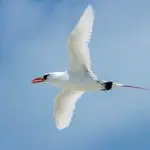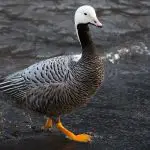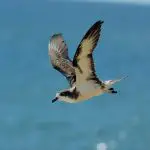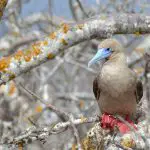Snow goose swimming | image by Cephas via Wikimedia Commons | CC BY 2.0
Common Name: Snow Goose
Scientific Name: Anser caerulescens| Size | Diet | Range in Hawaii | Status in Hawaii |
|---|---|---|---|
| 27 in. - 30 in. | grasses, grains, and aquatic plants | Oahu, Kauai, or Big Island | Least Concern |
The Snow Goose (Anser caerulescens) is a beautiful and iconic bird species that is native to North America. They are known for their distinctive honking calls, which can be heard from a distance.
Snow goose
Appearance
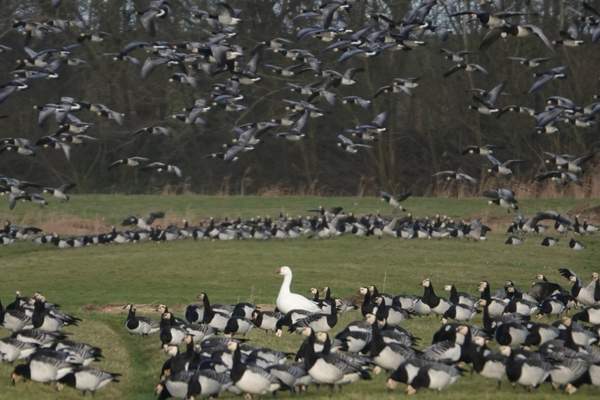
The Snow Goose is a medium-sized goose, with a length of about 27-30 inches and a wingspan of about 45-51 inches. The female is slightly smaller than the male, and adult Snow Geese weigh about 4-6 pounds.
The Snow Goose has a distinctive appearance, with a white body and black wingtips. It also has a pink bill, legs, and feet, and a blue-gray patch on the upper wings.
Juvenile Snow Geese are similar in appearance to adult Snow Geese, but they have a grayish-brown plumage, with white markings on their wings and tail. As they mature, their plumage becomes more white.
Diet
Snow Geese are herbivorous birds, meaning that they primarily feed on plants. Their diet consists of a variety of grasses, grains, and aquatic plants. During the breeding season, Snow Geese feed on a variety of plant material, including leaves, stems, roots, and seeds of grasses, sedges, and other plants that are found in the arctic tundra.
Behavior
Snow Geese are social birds and are often seen in large flocks, especially during migration. Snow Geese are highly vocal and use a variety of calls to communicate with each other, including honking, cackling, and yelping. They are also known for their elaborate courtship displays, which involve a variety of behaviors, including preening, head-bobbing, and wing-flapping.
Snow Geese are migratory birds and travel long distances between their breeding and non-breeding ranges. Snow Geese migrate in large flocks, often in a V-formation, which helps them to conserve energy and navigate over long distances. Snow Geese are strong and agile flyers and are able to cover long distances quickly.
Snow Geese use a variety of migration routes, depending on their breeding and non-breeding ranges, and they are able to adapt to different environments as they migrate. In addition to their migration behavior, Snow Geese are also known for their territorial behavior during the breeding season. Male Snow Geese are territorial and will defend their territory against intruders, including other male Snow Geese.
They will use a variety of aggressive behaviors, including vocalizations and physical displays, to defend their territory. Female Snow Geese are also territorial, but they are less aggressive than males. They will defend their territory against other females, but they are more likely to retreat or flee from a confrontation.
Nesting
They prefer to nest in areas with tall, dense vegetation, which provides cover and protection from predators. The female Snow Goose builds the nest, which is a shallow depression in the ground lined with grasses, feathers, and other materials.
The female lays a clutch of 2-8 eggs, which are incubated for about 25-30 days. Both the male and female take turns incubating the eggs and protecting the nest from predators.
When the eggs hatch, the goslings are altricial, meaning that they are born helpless and require constant care and protection from their parents. The goslings are covered in downy feathers and are able to walk and swim within a few hours of hatching. They are fed a diet of plant material and insects by their parents, and they grow quickly, fledging (leaving the nest) within 6-8 weeks.
After the goslings fledge, the family group remains together for a few more weeks, with the young goslings continuing to be fed and protected by their parents. When the goslings reach independence, they join a larger flock and begin their migration to their non-breeding range.
Habitat
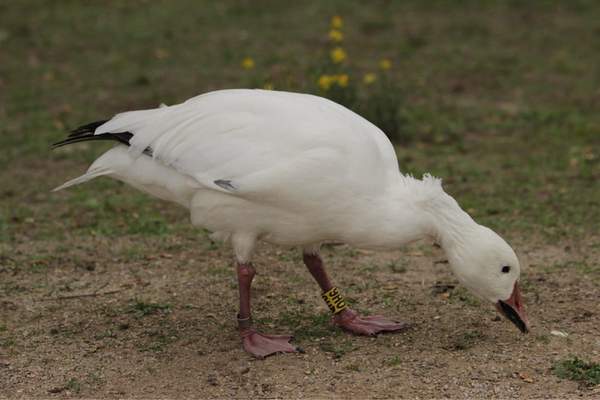
Snow Geese are highly dependent on wetland habitats, both for breeding and for feeding. They are found in a variety of habitats including wetlands, grasslands, agricultural fields, and urban areas.
Range
In Hawaii, Snow Geese are not a common species, and they are considered a rare visitor to the islands. If a Snow Goose does occur in Hawaii, it is most likely to be found on one of the main islands, such as Oahu, Kauai, or Hawaii Island.
However, it is important to note that sightings of Snow Geese in Hawaii are quite rare, and it is unlikely that you will see one if you visit the islands. The Snow Goose is more commonly found in its native range in the Arctic tundra and along the Pacific Coast of North America.
Conservation Status
According to the IUCN, the conservation status of Snow Geese is “least concern.” This classification indicates that Snow Geese are not currently considered to be at risk of extinction and that their populations are considered to be stable.
Interesting Facts
1. They are agile fliers
They are able to fly at speeds of up to 60 miles per hour and can fly for extended periods of time without stopping.
2. They are monogamous
Snow Geese are monogamous and typically mate for life, although if one member of a pair dies, the surviving member will often find a new mate.
3. Male and female names of their species
In scientific terminology, male Snow Geese are referred to as “cocks” or “ganders,” and female Snow Geese are referred to as “hens” or “geese.”
4. Baby Snow Goose name
A baby Snow Goose is generally referred to as a “gosling.” Goslings are altricial, meaning that they are born helpless and require constant care and protection from their parents.
Frequently Asked Questions
How long does a Snow goose live?
Snow Geese are able to live for up to 20 years in the wild.
How much does a Snow goose weigh?
Snow Geese are large birds, and their weight can vary depending on a variety of factors, including their age, sex, and size. Adult Snow Geese typically weigh between 4 and 6 pounds, although some individuals may be slightly lighter or heavier.
Does Snow goose can make a good pet?
It is generally not recommended to keep Snow Geese as pets. Snow Geese are wild birds and are not domesticated, and they have specialized care and habitat requirements that may be difficult for most people to provide. They are also protected by international and national laws and it is illegal to keep them as pets in some areas.

